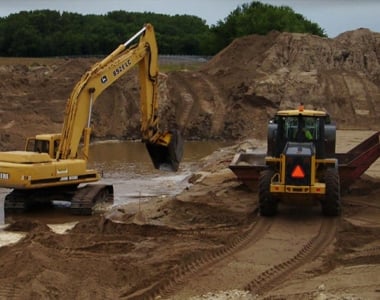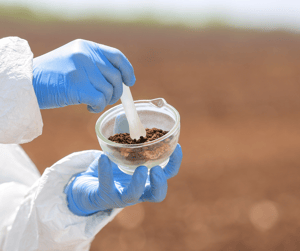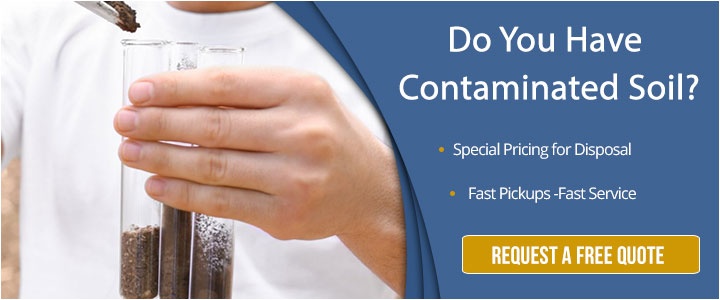Soil contamination is a growing concern worldwide, impacting the environment and public health. It occurs when harmful substances, such as heavy metals, chemicals and pollutants, enter the soil and pose a threat to the ecosystem and potentially human life.
Identifying and addressing soil contamination is crucial for preserving our environment and safeguarding public health. If you suspect soil contamination near your worksite, your first thought likely involves, “Where can I get help with soil contamination testing near me?”, so that you can know exactly what problem you may be dealing with now and in the long-term.
Where you receive that help often depends on what contaminants might be present and what types of treatments are available. In this article, we will explore common soil contaminants, the importance of testing, methods of soil contamination testing that may be available to you, who can help and best practices during this important process.
Common Soil Contaminants
Understanding common soil contaminants is vital when deciding whether soil testing is necessary since this knowledge can help with assessing potential risks, ensuring regulatory compliance and influencing land use planning and property values.
this knowledge can help with assessing potential risks, ensuring regulatory compliance and influencing land use planning and property values.
Common soil contaminants can vary depending on the location and sources of pollution, but several types are often encountered in soil contamination cases:
- Heavy Metals: Heavy metals like lead, mercury, cadmium and arsenic are widespread soil contaminants. They often originate from industrial activities, mining, and the use of leaded gasoline.
- Petroleum and Hydrocarbons: Oil spills, leaking underground storage tanks and industrial discharges can introduce petroleum hydrocarbons into the soil. These substances include gasoline, diesel, and various types of oils.
- Pesticides and Herbicides: Agricultural and landscaping activities can lead to the presence of pesticides and herbicides in the soil. Common examples include atrazine, glyphosate, and chlorpyrifos.
- Polycyclic Aromatic Hydrocarbons (PAHs): PAHs are organic compounds produced by the incomplete combustion of fossil fuels and various industrial processes. They include substances like benzo(a)pyrene and naphthalene.
- Persistent Organic Pollutants (POPs): POPs are highly toxic compounds that can persist in the environment for extended periods. Examples include polychlorinated biphenyls (PCBs), dioxins and certain organochlorine pesticides.
- Volatile Organic Compounds (VOCs): VOCs are organic chemicals that can readily evaporate into the air. Common soil contaminants in this category include solvents like benzene, toluene, ethylbenzene and xylene (BTEX).
- Chlorinated Solvents: These are often found at industrial sites and can include trichloroethylene (TCE) and perchloroethylene (PCE), which are used in various manufacturing processes and dry cleaning.
- Radionuclides: Soil can become contaminated with radioactive materials, including radium, uranium and thorium, through activities like mining, nuclear power generation, or improper disposal of radioactive waste.
- Asbestos: Asbestos-contaminated soil can result from the improper disposal of asbestos-containing materials and poses health risks due to the release of asbestos fibers.
- Sewage and Wastewater Contaminants: These contaminants can include pathogens, nutrients like nitrogen and phosphorus, and organic matter from domestic or industrial sewage and wastewater discharges.
- Inorganic Contaminants: Inorganic pollutants can include salts, acids and alkalis, often originating from industrial processes and the improper disposal of hazardous materials.
- E-waste Components: Electronic waste (e-waste) can contain heavy metals like lead and cadmium, as well as brominated flame retardants, which can leach into the soil when improperly managed.
- Construction and Demolition Debris: Building materials, such as asbestos-containing products, lead-based paints, and treated wood, can contaminate soil if not disposed of properly.
- Biological Contaminants: Soil can also be contaminated with biological agents like bacteria, viruses, and parasites, often originating from animal waste or sewage.
Soil contamination testing and remediation efforts are essential to assess the extent of contamination and mitigate its impact on the ecosystem and public safety. The specific contaminants found in a given location may vary, so site-specific assessments are typically required to identify and manage soil contamination effectively.
The Importance Of Soil Contamination Testing
Soil is a vital component of our ecosystem. It provides the foundation for plant growth, which sustains the food chain and supports a wide array of life on earth. When soil becomes contaminated, it can disrupt this delicate balance, leading to a cascade of negative consequences that include:
- Environmental Impact: Soil contamination can harm plants, animals and microorganisms that depend on a healthy soil environment, leading to a loss of biodiversity and disrupting ecosystems.
- Health Risks: Soil pollution can pose serious health risks to humans. Exposure to harmful chemicals and heavy metals in contaminated soil can lead to a variety of health problems, including cancer, respiratory issues and neurological disorders.
- Water Contamination: Soil contamination can also lead to the contamination of groundwater and surface water sources, affecting drinking water quality and aquatic life.
- Crop Contamination: When soil used for agriculture is contaminated, it can lead to tainted crops, posing health risks to consumers and economic losses to farmers.
Given the potential consequences of soil contamination, it is crucial to identify and address it promptly. For project managers who unearth potentially contaminated soil during construction or development projects, it’s crucial to perform soil testing and remediation right away.
In fact, understanding the significance of this process is vital for responsible project management, not only to protect human and environmental health, but to comply with state and federal regulations.
Construction and development projects often need to adhere to strict environmental regulations and permits. Unearthing contaminated soil without proper testing can result in legal consequences and fines.
Other reasons why soil contamination testing is important include:
- Risk Mitigation: Ignoring potentially contaminated soil can lead to unforeseen risks and liabilities. Soil contamination can worsen over time, causing health and environmental issues that may not manifest immediately. By promptly testing and addressing soil contamination, project managers can reduce long-term risks and protect their reputations.
- Cost Efficiency: Addressing soil contamination issues as soon as they arise is more cost-effective than dealing with them later in the project or after its completion. Delaying testing and remediation can lead to expensive clean-up efforts, delays and legal disputes, all of which can significantly impact a project's budget.
- Stakeholder Safety: Project managers have a responsibility to protect the safety and well-being of project stakeholders, including workers, contractors and nearby residents. Unknown soil contamination poses a potential threat to the health and safety of those involved in the project.
Once contaminated soil is suspected, it’s important for sampling and testing to occur so that the appropriate remediation measures can be implemented.
Methods Of Soil Contamination Testing
Several methods are available to test soil for contamination. The choice of method depends on the specific contaminants suspected and the level of accuracy required. Some common methods include:
contaminants suspected and the level of accuracy required. Some common methods include:
- Soil Sampling: The first step in soil contamination testing is collecting samples. These samples are typically collected from various depths and locations to obtain a representative picture of the soil’s contamination status. Soil samples are collected in sterile containers and are preserved to prevent further contamination.
- Laboratory Analysis: Soil samples are then sent to a laboratory for analysis. In the lab, scientists use a range of techniques to identify and quantify contaminants. These techniques can include chemical analysis, chromatography and mass spectrometry.
- On-Site Testing: In some cases, on-site testing methods may be employed. These are often less accurate than laboratory soil analysis but can provide quick results. On-site testing methods include pH testing, conductivity measurements and the use of handheld analyzers.
- Soil Profiling: Soil profiling involves examining the layers of soil to identify changes in color, texture and composition, which can indicate contamination. This is a useful preliminary technique for identifying areas of concern.
- Biological Testing: Biological tests involve using organisms such as earthworms or plants to assess the health of the soil. These tests can help identify the impact of contamination on the ecosystem.
- Geophysical Surveys: Geophysical methods, like ground-penetrating radar and electrical resistivity, can be used to detect anomalies in the soil that may suggest contamination.
If you lack the expertise or resources to conduct these tests, seeking assistance from soil contamination experts is essential for accurate and reliable results.
Where to Get Help with Soil Contamination Testing Near You
If you suspect soil contamination, it's essential to seek professional help to assess and address the issue. Here are some places where you can get assistance with soil contamination testing:
- Environmental Consulting Firms: Environmental consulting firms specialize in assessing and remediating environmental issues, including soil contamination. These professionals have the expertise and equipment to conduct soil testing and provide recommendations for remediation.
- Local Environmental Agencies: Many local and state environmental agencies offer assistance with soil contamination testing. They may provide resources, guidelines and, in some cases, even conduct testing themselves.
- University or Research Institutions: Universities and research institutions often conduct soil contamination research and may offer testing services. These institutions are staffed with experts in environmental science and soil testing.
- Private Laboratories: Many private laboratories offer soil contamination testing services. These labs can provide quick and accurate results for a fee.
- Local Agricultural Extension Offices: If you are concerned about soil contamination on your agricultural property, your local agricultural extension office can provide guidance and assistance. They may offer testing services or direct you to the appropriate resources.
- Online Resources: Online directories and resources can help you locate soil testing services near you. Websites, like the Environmental Protection Agency's (EPA) or state-specific environmental agency websites, often provide information on local soil testing services.
When seeking help with soil contamination testing, choose a reputable and accredited service provider. Ensure that they follow established testing protocols and have a track record of accuracy and reliability. Also, consider the cost of testing and any potential remediation services that may be needed.
Best Practices For Soil Contamination Testing And Clean-Up
Ensuring the safe and effective management of contaminated soil, responsible project management requires adhering to a set of best practices. These best practices include:
- Halt Work and Secure the Area: If you suspect soil contamination during a project, the first step is to halt any excavation or construction activities in the affected area to prevent the further spread of contaminants.
- Consult Environmental Experts: Reach out to environmental consultants or specialists with expertise in soil contamination testing and remediation. They can assess the situation, collect soil samples and conduct thorough testing to determine the nature and extent of contamination.
- Develop a Remediation Plan: Based on the test results, environmental experts can work with project managers to develop a remediation plan. This plan outlines the steps necessary to address the contamination, including excavation and disposal of contaminated soil, soil treatment or other appropriate remediation techniques.
- Comply with Regulatory Requirements: Project managers must work closely with environmental consultants to ensure that all necessary permits and regulatory requirements are met during the remediation process. This may involve working with local environmental agencies and adhering to established guidelines.
- Monitor and Verify Clean-Up: After remediation, it’s essential to monitor and verify the effectiveness of the clean-up efforts. Environmental experts will conduct additional testing to ensure that contamination levels are within acceptable limits.
- Communication and Reporting: Project managers should maintain open and transparent communication with all stakeholders, including clients, regulatory bodies and the public. Reporting on the soil testing, remediation efforts and results is essential to demonstrate a commitment to safety and environmental responsibility.
- Documentation: Thorough documentation of all testing, remediation efforts and communication is essential for legal and regulatory compliance, as well as for project records.
- Work with a Hazardous Waste Disposal Company: In the event of soil contamination, collaborating with a hazardous waste disposal company is a crucial step. These experts specialize in the safe transportation and disposal of contaminated soil, ensuring that it is handled in compliance with environmental regulations and best practices and mitigating risks associated with improper disposal.
Safe contaminated soil disposal relies on the expertise of a transporter who will help you with the following:
- Ensure that the soil is transported using appropriate vehicles, containers and handling procedures
- Comply with all local, state and federal regulations governing hazardous waste transportation
- Safely transport the contaminated soil to an approved disposal facility or treatment site.
- Maintain detailed records of the transportation process, including manifests and documentation of waste handling
- Minimize environmental impact and public health risks throughout the transportation process
If you do not discover that the soil you have excavated is contaminated until it arrives at the disposal site, where the facility performs routine testing before disposal, a hazardous waste transporter can help you through this process as well.
The best disposal companies will assist in managing unexpected contamination issues, which may involve re-evaluation of the remediation plan and coordination with environmental experts to determine the most appropriate course of action.
You Play A Critical Role
Project managers have a critical role to play in addressing soil contamination when it arises during construction and development projects. Prioritizing soil contamination testing, remediation, and compliance with regulations is essential for mitigating risks, protecting stakeholders and ensuring the long-term success and sustainability of projects.
By taking these steps, project managers can not only fulfill their responsibilities but also contribute to environmental protection and public health.


Comment